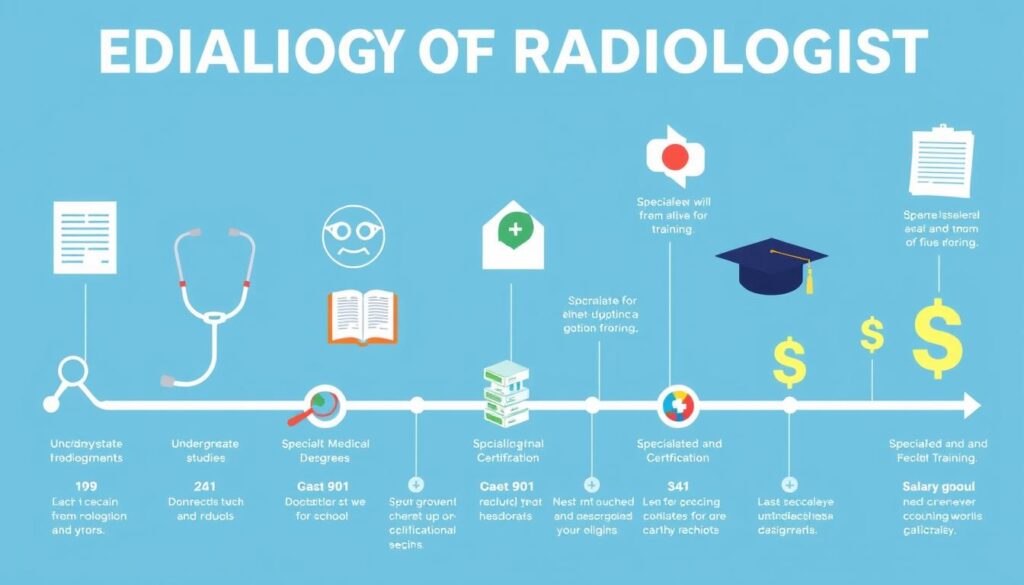Discover the expected radiologist salary trends for 2025. Learn about factors affecting earnings, regional variations, and how to maximize your income potential in radiology.
Did you know radiologists are among the top 5 highest-paid medical specialists in the U.S.? In 2025, their salaries show a bright financial future. This is great news for those in this field, let’s see radiologist salary.
Exploring what a radiologist earns reveals a promising career. The starting salary has grown a lot. This reflects the important skills and tech knowledge radiologists bring to healthcare.
Radiologists are key in medical diagnostics. They use advanced imaging to spot and understand complex health issues. Their deep knowledge leads to high pay, rewarding their hard work and training.
Key Takeaways
- Radiologists consistently rank among top-earning medical specialists
- Average annual salaries continue to show steady growth
- Specialized skills significantly impact earning potential
- Geographic location plays a critical role in compensation
- Advanced technological expertise drives higher salaries
Current Radiologist Salary Overview
Exploring the financial side of radiology careers is key for those in this field. Radiologists get paid well, thanks to their advanced skills and important role in healthcare.
The average annual salary for radiologists is $468,390. They make about $225 an hour. Their pay can change a lot based on different factors.
Base Salary Components
A radiologist’s pay comes from several parts:
- Base Salary: 76.8% of total compensation
- Bonuses: 2.5% of total earnings
- Additional benefits: Including healthcare, retirement plans, and time off
Hourly vs Annual Compensation
On average, radiologists make $225 an hour. This means they earn a lot each year. They are among the top earners in medicine.
“Radiology offers an exceptional financial trajectory for dedicated medical professionals.” – Medical Career Insights
Regional Variations in Pay
Where you work can greatly affect your pay. The highest earnings are found in:
- San Jose, CA: $587,890 annually
- San Francisco, CA: $585,490 annually
- New York, NY: $547,090 annually
Your pay will also depend on your experience, specialty, and the local job market.
Experience Level Impact on Radiologist Earnings
Your earnings as a radiologist change a lot with experience. Knowing how your salary grows can help you plan your career well.
Experience is key in how much a radiologist makes. Let’s look at the salary at different career stages:
- Entry-Level Radiologists (Less than 1 year): $440,889 annually
- Early Career (1-2 years): $445,426 annually
- Mid-Career (2-4 years): $449,963 annually
- Experienced Professionals (5-8 years): $456,315 annually
- Expert-Level Radiologists (8+ years): $470,830 annually
The salary goes up with more experience. Each stage adds about 1-2% to your yearly pay.
“Experience transforms your medical expertise into financial value” – Radiology Career Insights
| Experience Level | Annual Salary | Percentage Increase |
|---|---|---|
| Entry-Level | $440,889 | Baseline |
| Early Career | $445,426 | 1.0% |
| Mid-Career | $449,963 | 1.2% |
| Experienced | $456,315 | 1.4% |
| Expert-Level | $470,830 | 1.6% |
Your starting salary as a radiologist is just the start. As you gain more experience, your value in the market grows. This shows your increasing skills and abilities.
Top-Paying Cities for Radiologists in 2025
Location is key when looking at radiology salaries. Knowing the best cities can guide your career choices.
Salaries for radiologists vary a lot in the U.S. Some cities offer much higher pay.
Metropolitan Areas with Highest Salaries
In 2025, top cities for radiologist pay are:
- San Jose, California: Leading with average salaries around $587,890
- San Francisco, California: Close second with earnings near $571,490
- New York City metropolitan area: Competitive salaries reaching $547,090
- Oakland, California: Robust compensation packages
Cost of Living Adjustments
High salaries in cities come with a catch. The cost of living is often high too. This might not mean you can buy more than in cheaper places.
Urban vs Rural Compensation Differences
Urban radiologists make more than those in rural areas. But, rural jobs might have lower salaries. They also offer lower living costs and loan forgiveness.
“Location can be as important as specialization when determining radiologist earnings.” – Medical Compensation Research Institute
Choosing a career means balancing salary with lifestyle and growth. Think about what’s best for you.
Radiologist Salary Trends and Projections
Looking at the radiologist salary landscape for 2025 shows great opportunities for medical experts. The growth shows how important radiologists are in today’s healthcare.
Here are some key salary insights for radiologists in 2025:
- Average annual salary: $521,790
- 75th Percentile earnings: $603,690
- 25th Percentile earnings: $453,690
Experience greatly affects how much a radiologist makes. New radiologists can earn about $491,150. Those with 8+ years of experience can make up to $524,505.
“The radiologist salary continues to demonstrate strong growth, reflecting the increasing complexity and importance of diagnostic imaging in healthcare.”
Where you work also affects your salary. Places like San Jose, CA, and San Francisco offer high salaries. You could earn $587,890 and $585,490 there respectively.
Getting better at technology and developing special skills can also raise your salary. For example, knowing about Long Term Care can increase your pay by 13%. Knowing about Internal Medicine can raise it by 6.04%.
- Skill-based salary increases:
- Long Term Care: 13%
- Flexibility: 8%
- Insight: 8%
As you think about your radiology career, these salary trends show promising financial chances in this vital medical field.
Benefits and Compensation Packages
Exploring careers in radiology salary means looking at the whole package. Radiologists get more than just their salary. They also get benefits that add a lot of value to their job.
In 2025, radiologists will earn an impressive $609,552. This is thanks to many parts of their compensation package. Let’s look at what makes their salary so appealing.
Healthcare Benefits
Radiologists get great healthcare coverage, worth about $6,374 a year. This is about 1% of their total pay.
- Comprehensive medical insurance
- Dental coverage
- Vision care plans
- Mental health support
Retirement Plans
Financial security is key for radiologists. They have 401(k) and 403(b) plans to help with retirement.
| Retirement Plan | Average Contribution | Percentage of Total Compensation |
|---|---|---|
| 401(K)/403(B) | $10,000 | 1.6% |
| Pension Benefits | $13,750 | 2.3% |
Additional Perks
Radiologists also get extra perks:
- Disability insurance: $9,670 (1.6% of compensation)
- Social Security contribution: $17,464 (2.9% of total compensation)
- Paid time off: $68,804 (11.3% of total compensation)
- Performance-based bonuses
“The true value of a radiologist’s compensation goes well beyond the base salary, offering comprehensive financial protection and growth opportunities.”
These benefits make radiology a very appealing career. It offers financial stability and support for medical professionals.
Educational Requirements and Salary Correlation

To become a radiologist, you need a long educational journey. This journey affects your starting salary. It involves many stages of advanced training.
Your educational path includes:
- Completing a four-year undergraduate degree
- Graduating from an accredited medical school
- Finishing a comprehensive radiology residency program
- Potentially pursuing a subspecialty fellowship
Investing in education greatly impacts your salary. Most radiologists have advanced doctoral degrees. About 63.4% have a doctorate-level qualification. This education leads to higher earnings.
“Your educational credentials are a critical determinant of your future radiologist salary.” – Medical Career Insights
Radiologists with advanced degrees like MD, PhD, or equivalent earn between $449,745 and $487,162. The long training period leads to competitive salaries. It rewards deep medical knowledge.
Continuing education is key throughout your career. Employers like the Veterans Health Administration offer up to $1,000 annually for education. This supports your ongoing growth.
- Advanced degrees typically translate to higher starting salaries
- Subspecialty training can further enhance earning potential
Your dedication to education is crucial for your career success and salary in radiology.
Subspecialty Impact on Radiologist Earnings
Exploring the world of radiology careers shows how subspecialties can greatly affect your pay. The salary for radiologists changes a lot based on their specialty.
By choosing advanced subspecialties, radiologists can earn more. Let’s look at how different areas affect their hourly pay.
Interventional Radiology
Interventional radiologists are among the highest earners in radiology. They do minimally invasive procedures, which pay well.
- Specialized medical procedures
- Advanced technical skills
- Higher complexity of treatments
Nuclear Medicine
Nuclear medicine radiologists use advanced imaging to diagnose and treat diseases. Their unique skills often lead to good pay.
“Specialized knowledge in nuclear imaging can significantly enhance your earning potential” – Radiology Professional Association
Pediatric Radiology
Pediatric radiologists work with children, needing special training and skills. This niche offers good pay and career chances.
| Subspecialty | Average Annual Salary | Hourly Rate Range |
|---|---|---|
| Interventional Radiology | $600,000 | $280-$350 |
| Nuclear Medicine | $550,000 | $250-$320 |
| Pediatric Radiology | $525,000 | $240-$300 |
Choosing a subspecialty can greatly affect your future earnings. Radiologists who get specialized training often earn more and have more career options.
Private Practice vs Hospital Employment Earnings

Choosing between private practice and hospital employment can greatly affect your radiologist salary. Each option has its own financial benefits and challenges. It’s important to think carefully about these differences.
Private practice radiologists can earn more but face extra responsibilities. Your salary in private practice could be between $400,000 and $700,000. This depends on how well your practice does.
“The autonomy of private practice comes with both financial rewards and administrative challenges,” says Dr. Elizabeth Chen, a leading radiology career consultant.
Hospital jobs offer a steady income for radiologists. While your salary might be a bit lower, you get consistent benefits and less paperwork.
Compensation Comparison
| Employment Type | Average Annual Salary | Key Benefits |
|---|---|---|
| Private Practice | $500,000 – $700,000 | Higher earning potential, flexibility |
| Hospital Employment | $350,000 – $500,000 | Stable income, comprehensive benefits |
Key Considerations
- Private practice offers potential for higher radiologist salary
- Hospital jobs provide more predictable compensation
- Administrative costs impact private practice earnings
- Benefit packages differ between employment models
Think about your financial goals, work-life balance, and career plans when deciding. Knowing these details can help you make the most of your radiologist salary.
Career Advancement and Salary Growth
Your salary in radiology can grow a lot as you move up in your career. Radiologists see big pay increases as they gain more experience and skills. It’s important to know how to increase your earnings in this fast-paced medical field.
Radiologists see their salaries go up a lot as they get more experienced:
- Starting jobs pay around $300,000 to $400,000
- Those in the middle of their careers make $400,000 to $500,000
- Top radiologists with lots of experience can make $600,000 or more each year
“Strategic career development is key to maximizing how much does a radiologist make,” says Dr. Sarah Reynolds, leading radiology career consultant.
To grow your earnings, you need to plan your career wisely:
- Get specialized certifications
- Focus on in-demand subspecialties
- Take on leadership roles in healthcare
- Do research and teach at universities
Where you work and what you specialize in also affects your salary. Places like California and New York pay more, with top earners making up to $600,000 a year.
Conclusion
Exploring careers in radiology salary shows a bright future for radiologists in 2025. The salary reflects the high skill and knowledge needed in this field. With salaries reaching high levels, your hard work in medical training can pay off well.
Your earnings as a radiologist depend on several things. These include your area of focus, where you work, and how long you’ve been in the field. Salaries vary a lot, from hospitals to private practices. The data shows chances for growth, with radiologists doing detailed imaging like CT and MRI scans.
To make more money, focus on areas like interventional radiology or nuclear medicine. This can increase your value in the field. The world of medical imaging is always changing, offering great chances for those who keep learning and staying up-to-date.
Being a radiologist is more than just the money. It’s a chance to make a real difference in patient care and medical science. Your dedication to accuracy, learning, and staying current with technology will be key to a successful and rewarding career in radiology.


